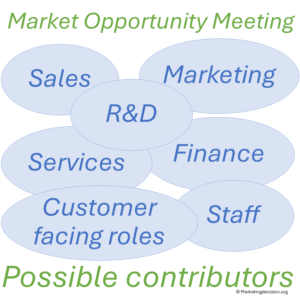Companies invest significant time and resources into analyzing the market environment. They uncover emerging trends, assess challenges, and evaluate the competitive landscape. Equally important is the process of constructing a marketing plan, allocating budgets, and deciding where to make strategic investments.
A Market Opportunity Meeting ensures that insights from market analysis translate into clear priorities and strategic investments.

This is the crucial juncture that lies between these two phases and is dedicated to identifying market risks and opportunities.
But what exactly are these risks and opportunities?
In simple terms, they represent the factors that can differentiate your company from competitors as you navigate a dynamic business landscape. For example, strategically positioning your offerings in rapidly growing market segments can generate substantial growth.
See also: Marketing Plan Creation
The identification of risks and opportunities is the foundational step in creating a high-performing business plan. A typical approach involves holding a meeting to review market trends, challenges, and company performance.

This initial meeting usually ends with an assessment of risks and opportunities. As a result, the outcomes can be refined and consolidated in a follow-up session.
Undoubtedly, this phase is key in shaping the direction and success of your business plan. It signifies the transition from comprehensive market analysis to action-oriented decision-making.
Having explored tools such as Porter’s Five Forces and PESTLE analysis, the time has come to ask:
“Based on our understanding of the market, what are the risks and opportunities that demand our attention in the pursuit of our development strategy?”

Organizing a Market Opportunity Meeting marks a crucial moment. It serves as a follow-up to earlier explorations of market trends and provides a refined understanding of market share, competition, product positioning, and performance.

Identifying opportunities requires the engagement of all teams and must be orchestrated as such. Every function—manufacturing, engineering, R&D, sales, marketing, finance, and more—can contribute ideas that help the company grow and differentiate.
👉 The best time for this collaboration is during budget planning meetings. This is when each team should propose new initiatives or ways to perform more efficiently.
The company’s objective is to prioritize and allocate a finite investment budget among multiple teams. To succeed, participants must have a clear mission: present projects that will strengthen the company’s future.

Teams should be organized to share their proposals, ensuring that they are listened to, reviewed, and challenged. While not all projects will be financed in a given year, every participant should feel empowered to present their best ideas.
Management plays a crucial role here. It must dedicate enough time for teams to prepare and present, and it should pay close attention to the insights shared. This process typically spans several months. As a result, teams have the opportunity to refine their proposals and maximize their impact.
Proposals should be simple, structured, and easy to compare. Depending on project size, descriptions may be short or extensive, but the essentials must always be included.

A practical way to ensure clarity is to structure each proposal around the “Why,” “What,” and “How.” Ideally, the full project can fit on a single page:
This structure makes proposals easier to understand, present, and prioritize during the meeting.
Not all projects will be brand new. Some may be variations or refinements of earlier proposals—and that is perfectly acceptable. What matters is that teams are given enough time to consolidate ideas and improve them over successive iterations.

The process usually follows the annual planning cycle:
This recursive, time-bound approach ensures that ideas are mature, realistic, and ready for decision-making when the final budget is set. It also keeps teams engaged throughout the year, rather than treating project proposals as a one-off exercise.

The management team plays a decisive role in creating a consolidated roadmap of meaningful projects. Different teams may present similar projects, which should be merged into one coherent initiative.
The primary responsibility of management is to prioritize and make decisions that support the company’s long-term success.
By conducting a Market Opportunity Meeting, companies can transform market analysis into actionable strategies. This process allows them to evaluate risks, uncover opportunities, and design a resilient business plan. In short, it aligns teams, sharpens decisions, and prepares the organization for sustainable growth.
© marketingdecision.org
A key tool for this chapter is the Decision Risk and Opportunity Tool which facilitates synthesis, presentation, and discussion across multiple business paths. Other approaches should also be considered.
Typically, the Decision Risk and Opportunity Tool is most effective after conducting a 360° market review and serves as a vital step before considering new investments.
Finally, the Market Opportunity Meeting should be carefully scheduled at the right moment in the company’s agenda to maximize impact.
The following section may include tools, some free, some with a fee to support this site development. If you consider a tool should be presented in this section and is missing, please let us know at: contact@marketingdecision.org
© 2025 MARKETING DECISION SOLUTIONS. All Rights Reserved.